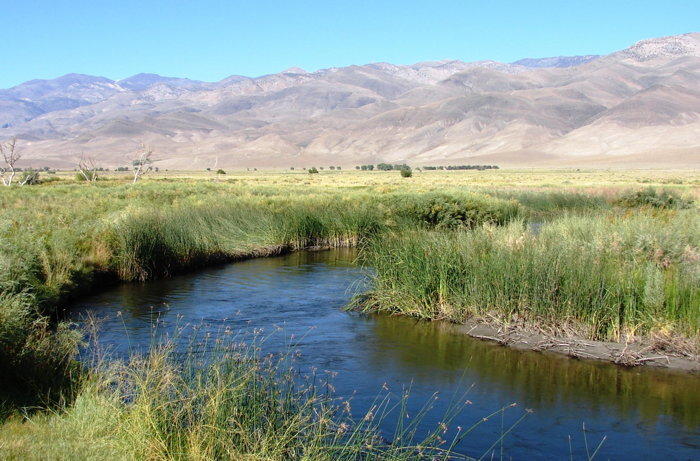By Dana Poblete
I had never really ruminated on where our water comes from until recently. Even after visiting Standing Rock last year and actively participating in a movement that’s largely about protecting water resources (among other issues such as indigenous sovereignty and treaty rights), it didn’t immediately click in my mind that the origin story of the water I shower in and drink every single day at home in Los Angeles is important, too. Sure, I knew that less snow in the Eastern Sierra had been a contributing factor to our years-long drought; but the complex history behind our water, which snakes its way down from the Sierra by way of the Owens River, eluded me.
Once upon a time, the Owens Valley was lush with swamps and orchards. The region was home to the Paiute tribe—innovators of irrigation who worked harmoniously with the natural ecosystem to engineer sophisticated networks of ditches, canals, and dams that would enable them to grow and subsist on native plants for thousands of years. The Paiute understood that water is life, and that diffusing it would keep the land, the wildlife, and future generations thriving. But when settlers usurped the Owens Valley in the 19th century, the Paiute were displaced—and their irrigation traditions and the inherent sustainability of those practices were lost.
Alan Bacock, tribal member of the Big Pine Paiute, commented about this devastating loss in a 2013 interview for Arid Journal: “We can see that this amnesia has impacted everything around us; we deal with the highest air pollution levels in the nation for [airborne] particulate matter, we look at springs that are dried up, we look at animals that are either extinct or now endangered because a group of select people in power throughout the last 100 years—in their desire to manage this place for themselves—have only managed to destroy this area.” Bacock was essentially referring to a second period of colonization in the early 20th century, when Los Angeles purchased about a quarter of a million acres in the Owens Valley for water acquisition. In 1913, the Owens River was diverted, from Owens Lake, to flow into a newly constructed Los Angeles Aqueduct in order to support agricultural expansion in LA County. By 1926, the lake, once a key rest stop for migratory birds, was desiccated. And to this day, the Paiute’s water rights remain unsettled.
A newly proposed Owens River water trail, which would be funded by a grant from the state of California, may present a chance for people of the Owens Valley—including Paiute that live there now—and Los Angeles to reconnect with water as an essential, life-giving resource. Just 200 miles north of LA, the water trail would comprise six miles of serene river for kayaking, canoeing, and other recreational activities. The Owens River is also listed as an Important Bird Area by Audubon California due to its location along the Pacific Flyway. This pristine ribbon of water cutting through the middle of an arid desert landscape is a sanctuary for wildlife, including a high concentration of birds like marsh wrens, yellowthroats, red-wing blackbirds, and yellow-headed blackbirds, according to Mike Prather, board member of Friends of the Inyo and chairman of the Inyo County Water Commission.
Prather says this year’s epic snowfall in the Sierra means Los Angeles will receive around 85 percent of its water via the Owens River, making the citizens of LA stakeholders in the river and the surrounding land. While the Owens River Water Trail may not be completed for at least a year and a half (considering the Los Angeles Department of Water and Power grants an access agreement to green-light the project), we at the Audubon Center in Debs Park think there’s no better time than now to see firsthand where our water comes from. In this place, chances are good you’ll find solitude amongst the staggering Sierra and the Alabama Hills, the sweeping Owens Valley, and the tranquil flow of the Owens River. For one moment in time, you can tap into the fundamental connection we and every living, breathing thing, including the land itself, all share with water.
To get to the site of the proposed Owens River Water Trail, head north on 395 to Lone Pine. Drive through to the north end of town, then turn right on Narrow Gauge Road until you reach the river crossing.







